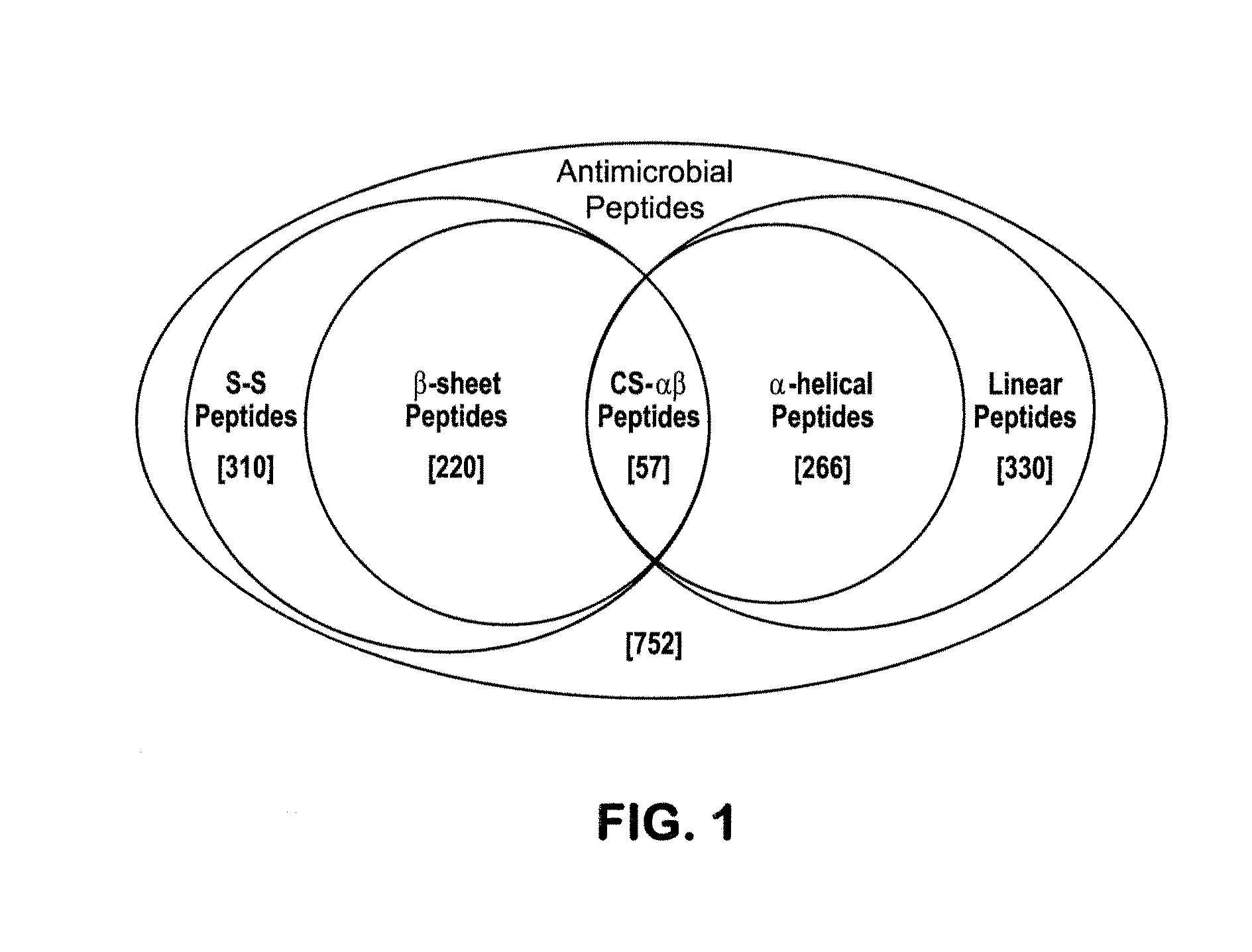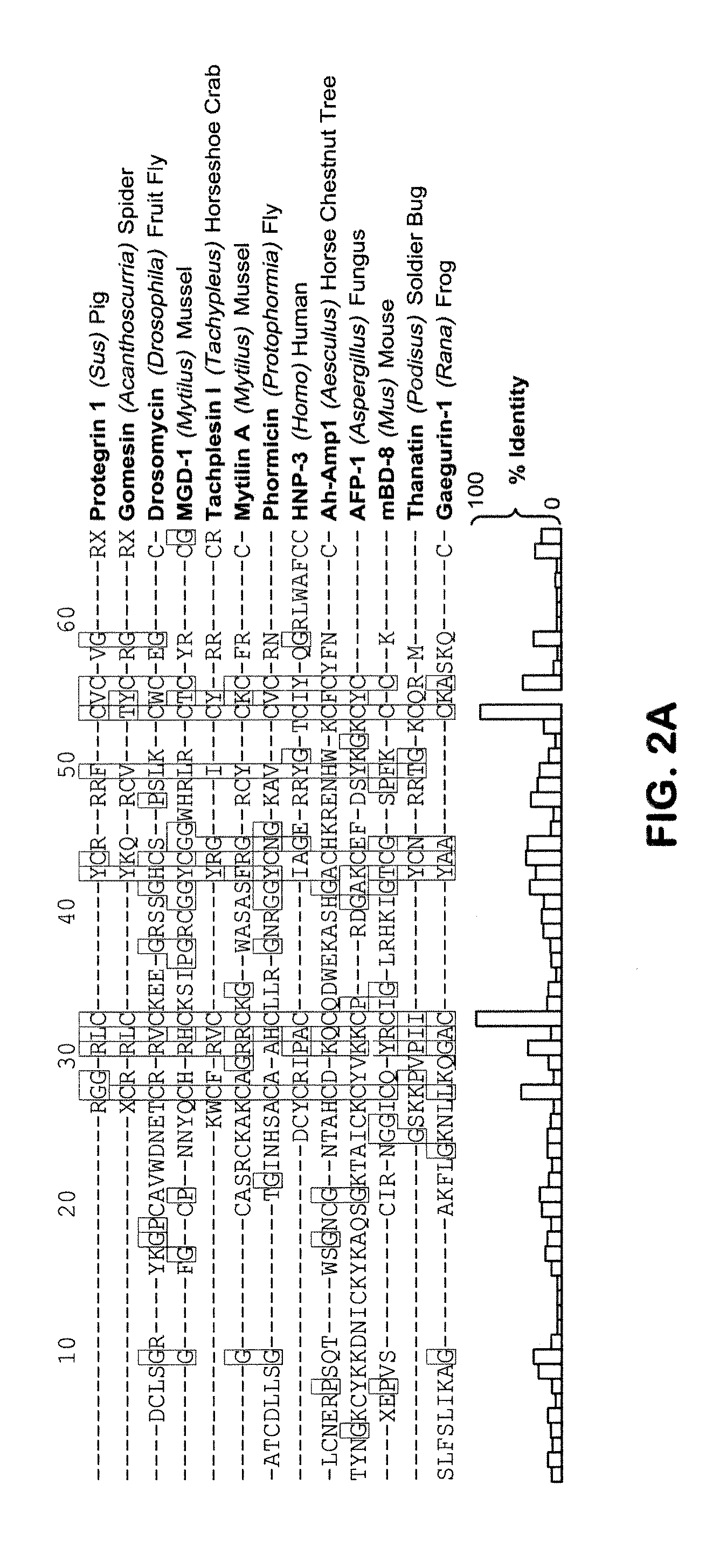Antimicrobial kinocidin compositions and methods of use
a technology of kinocidin and composition, applied in the field of antibacterial and antifungal properties of peptides, can solve the problems of limited sequence conservation, limited structural repertoire, and comparatively little knowledge of more comprehensive relationships between all antimicrobial peptides
- Summary
- Abstract
- Description
- Claims
- Application Information
AI Technical Summary
Benefits of technology
Problems solved by technology
Method used
Image
Examples
example i
Identification of Multidimensional Signatures of Antimicrobial Peptides
[0104]This Example shows identification of a disulfide-stabilized core motif that is integral to the 3-dimensional signature of cysteine-containing antimicrobial peptides.
[0105]The relatedness amongst primary structures was examined in prototypic cysteine-containing antimicrobial peptide sequences representing taxa spanning an evolutionary distance of 2.6 billion years (BY; estimated date of phylogenetic divergence of fungi and plants from higher organisms; Nei et al., Proc. Natl. Acad. Sci. USA. 98:2497 (2001)). A prototype from each class of non-cyclic, disulfide-containing antimicrobial peptides was represented in these analyses [Antimicrobial peptides were selected from the National Center for Biotechnology Information (NCBI) Entrez Protein (www.ncbi.nlm.nih.gov:80 / entrez / ) or Antimicrobial Sequences (www.bbcm.univ.trieste.it / ˜tossi / ) databases.]
[0106]The specific criteria for selection of peptides analyzed i...
example ii
Validation of the Multidimensional Antimicrobial Peptide Signature Model
[0118]The multidimensional signature model for antimicrobial peptides integrates a stereospecific (dextromeric or levomeric) sequence pattern with the 3-dimensional gamma-core (“γ-core”). Therefore, this model predicted that peptides fulfilling these prerequisites would exert antimicrobial activity, even though such activity may not yet have been determined. Multiple and complementary approaches were used to test the model in this regard: 1) prediction of antimicrobial activity in peptides fulfilling the sequence and conformation criteria of the multidimensional signature, but not yet recognized to have antimicrobial activity; 2) predicted failure of antimicrobial activity in peptides exhibiting primary sequence criteria, but lacking the 3-dimensional γ-core signature of the model; and 3) prediction of a γ-core motif in disulfide-containing peptides with known antimicrobial activity, and which fulfilled primary ...
example iii
Validation of the Multidimensional Antimicrobial Peptide Signature Model
[0125]This example demonstrates the discovery of iterations of the γ-core motif in kinocidins and validation of the antimicrobial signature model in human IL-8.
[0126]A bioinformatics approach was used to specify and compare phylogeny and homology among kinocidin iterations of the γ-core motif previously identified in proteins with known or predicted antimicrobial function (Yount, N. Y. & Yeaman, M. R. (2004) Proc Natl Acad Sci USA 101, 7363-8). The kinocidin γ-core (γKC core) signature is an iteration of the antimicrobial peptide γ-core (γAP), conforming to an anti-parallel β-hairpin comprised of a 13-17 amino acid pattern with a central hydrophobic region typically flanked by basic residues. The γKC core motif can be characterized by the following consensus sequence formula:
PUM
| Property | Measurement | Unit |
|---|---|---|
| pH | aaaaa | aaaaa |
| pH | aaaaa | aaaaa |
| pH | aaaaa | aaaaa |
Abstract
Description
Claims
Application Information
 Login to View More
Login to View More - R&D
- Intellectual Property
- Life Sciences
- Materials
- Tech Scout
- Unparalleled Data Quality
- Higher Quality Content
- 60% Fewer Hallucinations
Browse by: Latest US Patents, China's latest patents, Technical Efficacy Thesaurus, Application Domain, Technology Topic, Popular Technical Reports.
© 2025 PatSnap. All rights reserved.Legal|Privacy policy|Modern Slavery Act Transparency Statement|Sitemap|About US| Contact US: help@patsnap.com



